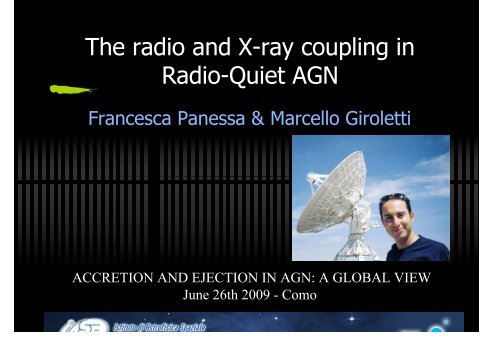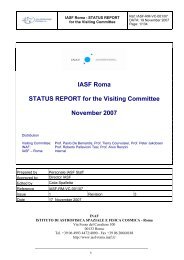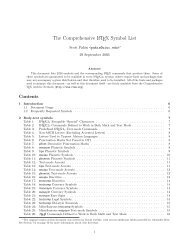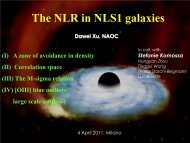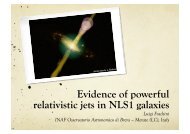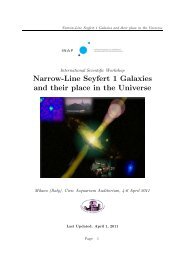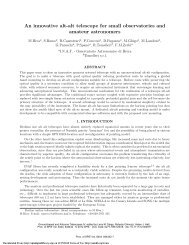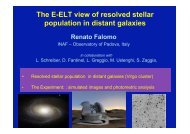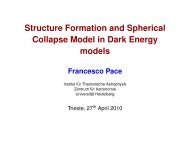The radio and X-ray coupling in Radio-Quiet AGN - Accretion and ...
The radio and X-ray coupling in Radio-Quiet AGN - Accretion and ...
The radio and X-ray coupling in Radio-Quiet AGN - Accretion and ...
You also want an ePaper? Increase the reach of your titles
YUMPU automatically turns print PDFs into web optimized ePapers that Google loves.
<strong>The</strong> <strong>radio</strong> <strong>and</strong> X-<strong>ray</strong> <strong>coupl<strong>in</strong>g</strong> <strong>in</strong><strong>Radio</strong>-<strong>Quiet</strong> <strong>AGN</strong>Francesca Panessa & Marcello GirolettiACCRETION AND EJECTION IN <strong>AGN</strong>: A GLOBAL VIEWJune 26th 2009 - Como
<strong>Radio</strong> <strong>Quiet</strong> vs <strong>Radio</strong> LoudR * 5 GHz ~ 10<strong>Radio</strong> Loud objects: Large scale <strong>radio</strong> lobes Compact lum<strong>in</strong>ous cores often withapparent lum<strong>in</strong>al motions<strong>Radio</strong> <strong>Quiet</strong> (Seyferts): Fa<strong>in</strong>t <strong>radio</strong> sources Emission conf<strong>in</strong>ed to sub-kpc scaleR = L(5 GHz) / L(B) --> Log R = 10Recent VLA & VLBA surveys show that all<strong>AGN</strong> are <strong>radio</strong> sources at some level(Ho&Ulvestad 2001; Nagar et al. 2002, 2005)
Orig<strong>in</strong> of <strong>radio</strong> emission <strong>in</strong> <strong>Radio</strong> <strong>Quiet</strong>L x,rjet dom<strong>in</strong>ation – disk dom<strong>in</strong>ationWhich is the orig<strong>in</strong> of <strong>radio</strong>emission <strong>in</strong> Seyfert galaxies?How it is related to the accretionflow? To the accretion rate?low-stateDiskJethigh-state At lower accretion rates disksbecome less <strong>and</strong> less prom<strong>in</strong>ent,jets rema<strong>in</strong> strong.(A/C)DAF+ JetM &critM &eddKörd<strong>in</strong>g, Falcke, & Markoff (2002);see also Fender, Gallo, & Jonker (2003)M &Analogy with black hole X-<strong>ray</strong> b<strong>in</strong>aries
Multi-wavelength analysis of the PalomarSeyfert Complete Sample60 Seyfert galaxies (13 type 1, 39 type 2, 8 “Mixed Seyferts”) XMM-Newton & Ch<strong>and</strong>ra X-<strong>ray</strong> images <strong>and</strong> spectra (Cappi et al. 2006,Panessa 2004) Accurate optical classification (Ho et al. 1997) Optical, X-<strong>ray</strong>, M BH correlations (Panessa et al. 2007) VLA & VLBI observations (Ho&Ulvestad 2001, Nagar et al. 2002)
Scal<strong>in</strong>g Relations: L 2-10 keV vs. L <strong>Radio</strong>RQPanessa et al. 2007, A&ARLLow Lum<strong>in</strong>osity <strong>Radio</strong> Galaxies(Balmaverde&Capetti 2005)From VLA surveys + HST + Ch<strong>and</strong>ra <strong>The</strong> two correlations extend for 8 orders ofmagnitude --> down to the regime ofLow-Lum<strong>in</strong>osity <strong>AGN</strong>sIn <strong>Radio</strong> <strong>Quiet</strong> Some physical parameter that l<strong>in</strong>ks the jetrelated power to the corona emission: ex.Corona at the base of the jet <strong>Radio</strong> <strong>and</strong> X-<strong>ray</strong> emission produced <strong>in</strong>outflows(Merloni et al. 2003, Ghisell<strong>in</strong>i et al. 2004)
<strong>Radio</strong> LoudnessAre all Sey galaxies <strong>Radio</strong>-Loud or need a redef<strong>in</strong>ition of the<strong>Radio</strong>-loudness boundary at low lum<strong>in</strong>osities?Log R = 1RQRLR = L(5 GHz) / L(B)R(X) = L(5 GHz) / L(2-10 keV)
<strong>Radio</strong> LoudnessMaximum separation between the twodistributions:New boundaries at low lum<strong>in</strong>osities?Log R = 2.40 ± 0.05Log R X = -2.76 ± 0.02
<strong>Radio</strong> Loudness<strong>Radio</strong>-Loud <strong>AGN</strong> are associated with massive BHs
<strong>Radio</strong> Loudness Increas<strong>in</strong>g <strong>radio</strong>-loudness withdecreas<strong>in</strong>g Edd<strong>in</strong>gton ratio?(Ho et al. 2002, Sikora et al. 2006)● <strong>The</strong> formation of a jet <strong>in</strong> LL<strong>AGN</strong>is related to the accretion rate as<strong>in</strong> XRBs?Need to look at the <strong>radio</strong>emission first to see if jets arethere: Let’s go for VLBI!
VLBI Observations of <strong>Radio</strong> <strong>Quiet</strong> NucleiDiscrim<strong>in</strong>ate between jet synchrontron, SSA, ADAF, free-freeemission? Physical constra<strong>in</strong>ts: Compactness of the source (ADAF < 10 4 R S ) Brightness temperature limits (high T B -> non thermal emission) Spectral <strong>in</strong>deces (flat or <strong>in</strong>verted --> ADAF or SSA) Motions (relativistic/sub-relativistic)
VLBI Observations of <strong>Radio</strong> <strong>Quiet</strong> Nuclei NGC 4151: <strong>radio</strong>-quiet Sey 1.5 nucleus <strong>Radio</strong> source size < 0.035 pc, BLRscales VLBI compact flat-spectrum <strong>radio</strong>component with Tb > 2.1 * 10^8 K A weak two sided beg<strong>in</strong>n<strong>in</strong>g to thelarge scale <strong>radio</strong> jet Sub-relativistic motionsVLBI at 15 GHz Ulvestad et al. 2005
NGC 1068: S1 component resolved<strong>in</strong>to an extended 0.8 pc longstructure oriented perpendicular tothe jet <strong>and</strong> aligned to the maser disk <strong>The</strong>rmal free-free emission from anX-<strong>ray</strong>-heated corona or w<strong>in</strong>d aris<strong>in</strong>gfrom molecular diskVLBA + phased-VLA 1.4 GHz contour imageGallimore et al. (2004) + H O MaserLow T b2.5 * 10^6 K <strong>and</strong> flat-<strong>in</strong>verted spectrum
VLBI Observations of <strong>Radio</strong> <strong>Quiet</strong> Nuclei NGC 4395: <strong>radio</strong>-quiet type 1 nucleuswith L X /L Edd = 0.004 Brightness temperature > 2 * 10^6 K VLBI elongated structure whichsuggests <strong>radio</strong> outflow on sub-pc scalesVLBA HSA at 1.4 GHz(SCALE of 0.021 pc/mas)Wrobel & Ho (2006)
VLBI Observations of a distance limitedComplete Sample of Seyferts Complete sample of 27 Seyfert nearby galaxies(Cappi et al. 2006, D < 27 Mpc) For the first time sources with S < 1mJy (VLA cores) European VLBI Network (EVN) new observations for 5objects to complete the sample at mas scales
New EVN Observations:NGC 4388Type 1.9 Seyfert galaxyDetected at 1.6 GHz (not at 5 GHz)-> very steep α > 1.3Compact <strong>radio</strong> emission at 1.3 mJyExtension of 6 mas (0.48 pc)T B = 10 6 KH 2 O Maser emission Log L (5 GHz)/L(2-10 keV) < -6.4Giroletti & Panessa <strong>in</strong> preparationFree-free emission from the torus?
New EVN Observations: NGC 4501Sy 1.9 galaxy detected 1.6 GHz(a peak brightness of 0.7 mJy/ beam)EVN account for a large fraction of the20 cm VLA flux density -> the <strong>radio</strong>source is highly compactT B > 10 6 K - l<strong>in</strong>ear size 0.6pcNot detected at 5GHz -> steepspectrum or resolved emission? Log L (5 GHz)/L(2-10 keV) < -4.2 Very low Edd<strong>in</strong>gton ratio (10 -6 )Synchrotron emissionfrom a compact jet?
New EVN Observations NGC 5033Sy 1.5 galaxy detected 1.6 <strong>and</strong> 5 GHzVLA found a jet-like structureUnresolved - Flat spectrum (α-0.1)T B > 3 x 10 6 K - l<strong>in</strong>ear size < 0.27 pc Log L (5 GHz)/L(2-10 keV) = -4.9 Very low Edd<strong>in</strong>gton ratio (10 -4.3 )ADAF or jet base?
New EVN Observations NGC 4051Sy 1.2 detected 1.6 <strong>and</strong> 5 GHz3 sub-mJy components: Two associated with the VLAsmall scale double structure Third is symmetric to theeasternmost one Steep spectral <strong>in</strong>dex (α = 0.7)T B = 10 5 K - l<strong>in</strong>ear size < 0.31 pc Log L (5 GHz)/L(2-10 keV) = -5.8 Very low Edd<strong>in</strong>gton ratio (10 -3.4 ) H 2 O Maser co<strong>in</strong>cident with core Synchrotron from jet or outflow?
New EVN Observations NGC 5273Sy 1.5 detected with VLA (1.4 <strong>and</strong>5 GHz) flat componentEVN non detection!!!(< 90 microJy at 1.6 GHz) Log L (5 GHz)/L(2-10 keV) < -6 Very low Edd<strong>in</strong>gton ratio (10 -3.4 )Resolved <strong>radio</strong> emission or variable?
VLBI Observations of a distance limitedComplete Sample of Seyferts 80% of the sample detected: very good rate given thevery low flux -> we are sampl<strong>in</strong>g the microJy sources!! <strong>Radio</strong> emission at sub-parsec scales (~BLR), no matterhow fa<strong>in</strong>t! EVN emission account only for a 5-30% VLA emission-> the sub-pc cores are extremely RADIO QUIET NGC 5273, a type 1 nucleus not detected! If resolved, no<strong>radio</strong> nucleus. Maybe variable at <strong>radio</strong> freq?Giroletti & Panessa, <strong>in</strong> prep.
Bright Seyfert nuclei display <strong>radio</strong> jets <strong>and</strong>/or outflows Large range of brightness temperatures Very steep, Flat or <strong>in</strong>verted spectra Proper motions NEW EVN observations ARE COMING of the fa<strong>in</strong>testsources!


